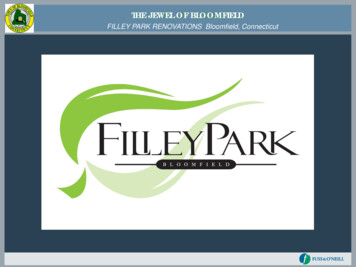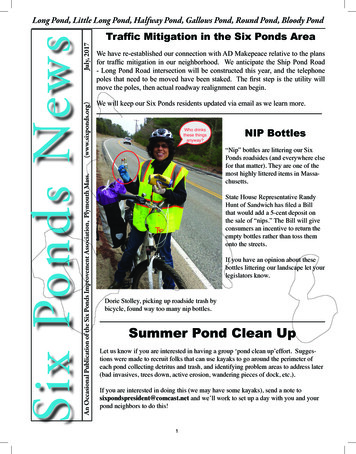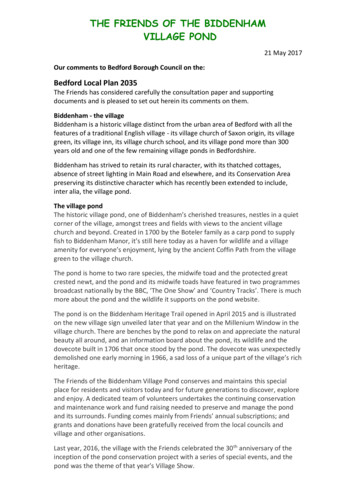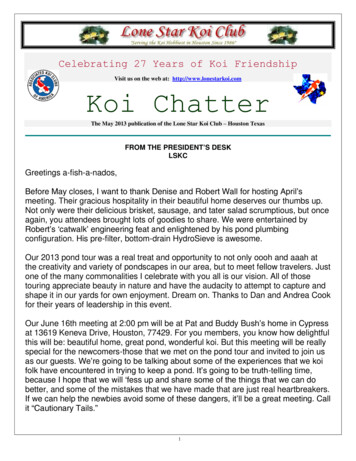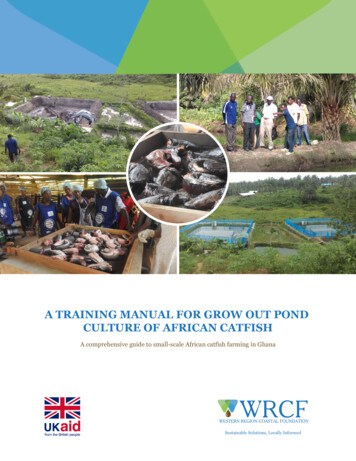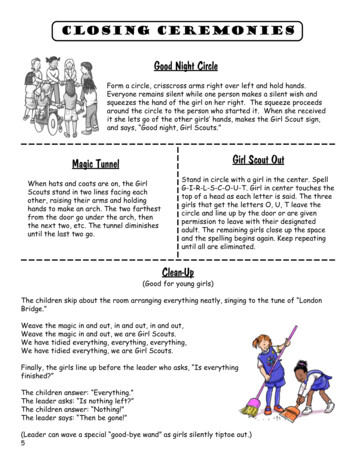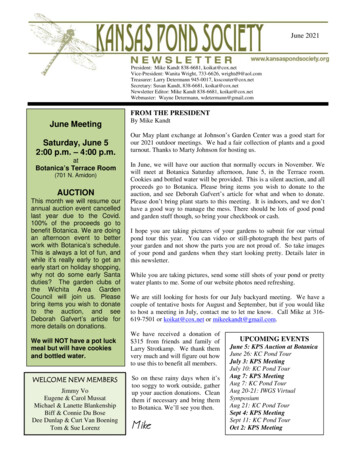
Transcription
June 2021President: Mike Kandt 838-6681, koikat@cox.netVice-President: Wanita Wright, 733-6626, wrightd9@aol.comTreasurer: Larry Determann 945-0017, ksscouter@cox.netSecretary: Susan Kandt, 838-6681, koikat@cox.netNewsletter Editor: Mike Kandt 838-6681, koikat@cox.netWebmaster: Wayne Determann, wdetermann@gmail.comFROM THE PRESIDENTJune MeetingSaturday, June 52:00 p.m. – 4:00 p.m.atBotanica’s Terrace Room(701 N. Amidon)AUCTIONThis month we will resume ourannual auction event cancelledlast year due to the Covid.100% of the proceeds go tobenefit Botanica. We are doingan afternoon event to betterwork with Botanica’s schedule.This is always a lot of fun, andwhile it’s really early to get anearly start on holiday shopping,why not do some early Santaduties? The garden clubs ofthe Wichita Area GardenCouncil will join us. Pleasebring items you wish to donateto the auction, and seeDeborah Gafvert’s article formore details on donations.We will NOT have a pot luckmeal but will have cookiesand bottled water.WELCOME NEW MEMBERSJimmy VoEugene & Carol MussatMichael & Lanette BlankenshipBiff & Connie Du BoseDee Dunlap & Curt Van BoeningTom & Sue LorenzBy Mike KandtOur May plant exchange at Johnson’s Garden Center was a good start forour 2021 outdoor meetings. We had a fair collection of plants and a goodturnout. Thanks to Marty Johnson for hosting us.In June, we will have our auction that normally occurs in November. Wewill meet at Botanica Saturday afternoon, June 5, in the Terrace room.Cookies and bottled water will be provided. This is a silent auction, and allproceeds go to Botanica. Please bring items you wish to donate to theauction, and see Deborah Gafvert’s article for what and when to donate.Please don’t bring plant starts to this meeting. It is indoors, and we don’thave a good way to manage the mess. There should be lots of good pondand garden stuff though, so bring your checkbook or cash.I hope you are taking pictures of your gardens to submit for our virtualpond tour this year. You can video or still-photograph the best parts ofyour garden and not show the parts you are not proud of. So take imagesof your pond and gardens when they start looking pretty. Details later inthis newsletter.While you are taking pictures, send some still shots of your pond or prettywater plants to me. Some of our website photos need refreshing.We are still looking for hosts for our July backyard meeting. We have acouple of tentative hosts for August and September, but if you would liketo host a meeting in July, contact me to let me know. Call Mike at 316619-7501 or koikat@cox.net or mikeekandt@gmail.com.We have received a donation of 315 from friends and family ofLarry Strotkamp. We thank themvery much and will figure out howto use this to benefit all members.So on these rainy days when it’stoo soggy to work outside, gatherup your auction donations. Cleanthem if necessary and bring themto Botanica. We’ll see you then. UPCOMING EVENTSJune 5: KPS Auction at BotanicaJune 26: KC Pond TourJuly 3: KPS MeetingJuly 10: KC Pond TourAug 7: KPS MeetingAug 7: KC Pond TourAug 20-21: IWGS VirtualSymposiumAug 21: KC Pond TourSept 4: KPS MeetingSept 11: KC Pond TourOct 2: KPS Meeting
SWAP SHOPIf you have articles, plants or fish to sell or give away, let me know at 838-6681 or koikat@cox.netBaby Koi - Some Butterfly. Sizes 4-5”. Quantity about 70. Variety of mixed colors: Yellow/Black,Orange/White, Orange/Black, Orange/Grey. Contact Mike Kraft (316) 641 0133 or mkksucats1@hotmail.com.Text is best, email second; it’s difficult for me to answer phone calls. Be sure to leave a voicemail; otherwise Iblock a bunch of unknown callers. I live in the NW part of the city, 29th/Ridge.Free Koi - 4-5 koi to give away. Call Jeff & Brenda Anderson at 316-708-9015Need Goldfish - I killed all 45 of mine. Stupid me, and dechlorinator was my weapon ofchoice. Could we ask in the newsletter if any members need to get rid of some fish and ifthey would trust me with them? Contact Carol Daney at cdaney007@gmail.com or (316)685-3779 - cell 214-6379Spider Lily – Free bulbs. I divided late and have about 20 bulbs. These are not winterhardy but are very vigorous and have a nice summer bloom. Call Mike at 316-619-7501 orkoikat@cox.net or mikeekandt@gmail.com.WATER PLANTSCollected from various internet sources by Mike KandtFour Leaf Water Clover(Marsilea mutica)Four Leaf Clover is a creeping aquatic fern with bright green leaves. If submerged,some of the clover leaves will float on the surface, while others stand upright outof the water. The 1" to 2" four leaf clovers float on the water surface, sending theirroots into the soil where they can. Four Leaf Water Clover is a charming additionto the water garden, a fast grower and a good plant to help cover the water surface.Hardiness Zone: 5-11Planting Container: Recommend a 2-gallon solid plantingcontainer or a medium planting bag.Light Requirements: Full sun to part shadeHeight: 1" - Spread: RunningWater Depth: Moist Soil or water up to 3' deep (Maximumwater depth is for mature bog plants). Shallow is best forgrowing.This plant is hard to find. It is considered invasive in manystates, including Oklahoma. While sources say it is hardy tozone 5, I have not had good luck wintering this plant. Considerdropping the plant to the pond bottom in winter and raising it inthe spring.LOST AND FOUNDThis folding chair was left at the lastmeeting. Contact Mike Kandt at 316619-7501 or koikat@cox.net ormikeekandt@gmail.com.MEMBERSHIP CARDSAlso, please note that your membership cardis good thru December 31st, which is thesame date through which your annual duesare paid. EACH YEAR YOU WILL NEEDA NEW MEMBERSHIP CARD FOR THENEW YEAR. The vendors who are sogenerous with their discounts to ourmembers have committed to honoringmembership discounts for active cards forthe current year only. They have notcommitted to giving discounts on expiredcards. We truly appreciate their generosityand ask that everyone honor them by beingconsiderate and showing them only currentyear membership cards. In lieu of having amembership card with you when you shopat Hong’s only, you can pay for anotheryear’s membership right there, which willcredit toward your next year’s dues.
NEW WEBSITEPASSWORDMEMBER PERKSANDOVER RENTAL CENTER- 10% DISCOUNTHILLSIDE FEED & SEED ------ 10% DISCOUNT (everything instore)HONG’S LANDSCAPE -------- 25% OFF POND PRODUCTSKANSAS NATURAL STONE– 10% DISCOUNT (on all stone)LIVING WATERS -------------- 50.00 OFF ANY SERVICElivingwatersict.comSCENIC LANDSCAPE --------- 10% DISCOUNT (pond plants &supplements -Dechlorinator, beneficial bacteria, etc.)WOODARD MERCANTILE ----- 2.00 off 20-lb fish foodEvery year we change the password tothe “Members” tab on our website:www.kansaspondsociety.org.We do this to restrict access to paidmembers only. The current password is:bogfrog(All “lower case”)Please do not give this to friends who arenot paid members.YOU MUST SHOW YOUR CURRENT MEMBERSHIP CARDTO RECEIVE THE DISCOUNTSTHE INTERNATIONAL WATERLILY ANDWATER GARDENING SOCIETYThe Kansas Pond Society is now a member of the International Waterlily &Water Gardening Society. As such, we now have access to the IWGS website.Go to IWGS.org, click on Log In and enter:User ID: Kansas Pond Society (with spaces between words)Password: KansasPondsOnly one member can use the website at a time unless you subscribe as an Individual Member, whichis recommended. It’s only 25 per year.Bill Vawter & Associates, Inc.Insurance and Financial Services110 E Waterman, Suite 150, Wichita, KS 67202Office 316-789-1919 Email Bill@Billvawter.com.In the Insurance Business since 1984. Helpingpeople with Insurance and Financial PlanningOffering Quality Products from Selected CompaniesAnnuities, Health, Life, Long Term Care Insuranceand All lines of Medicare Insurance.Please call me for quotes from multiplecompaniesKPS EQUIPMENT FORLOANThe Kansas Pond Society has a 3,000-gphsubmersible pump and discharge hose andtwo water meters that members may borrowwhen you clean out your ponds. The watermeters are critical for determining the exactvolume of water that your pond and streamhold. The only thing we ask is that you pickthem up and return them quickly so that othersmay use them. If you are interested, call Mikeat 838-6681 or 619-7501.ADVERTISING RATESBusiness Card Size Ad (about 2" x 3 ½"): 15 / 3-month period; 50 / yrQuarter-Page Ad (about 3 ½" x 4 ½"): 30/ 3-month period; 100 / yrHalf-Page Ad (about 5" x 7 ½"): 60 per 3-month period; 200 per yearFull-Page Ad (8 ½” x 11"): 400/ yr
KANSAS POND SOCIETY -----------------------------The Kansas Pond Society invites the Wichita Area Garden Clubs and garden community to our annualauction, Saturday, June 5, 2-4 pm, at Botanica. One hundred percent of proceeds benefit Botanica. Thisauction has generated over 10,000 in gifts to Botanica since its inception.Admission is free to all garden club members. Cookies and bottled water will be provided. Sorry, no potluck dinner yet. Past auction items have included gift certificates from area vendors patronized by clubmembers, new or gently used garden/pond-themed items, everything from giftable plants (example:succulent dish gardens), candles, art, books, garden/pond/yard equipment or supplies, decor likestatuary, lanterns, chimes, etc, garden-concept clothing & jewelry, earthy handcrafts like hypertufa andart ceramics, art glass, stained glass, "earthy" music, exquisite handmade woodwork, garden/naturethemed holiday items, nature- themed interior decor, pond equipment, rain barrels, outdoor furniture,wheelbarrows. Usually there are several very nice gift baskets loaded with delights for all the senses.If you wish to donate items to the auction, please bring your items after 1 PM before the meeting. Donot bring earlier, as Botanica has no way to receive and store these early. If you cannot attend but wantto donate early, contact Mike at 316-619-7501 or mikeekandt@gmail.com.Truly something for everyone! Bring your friends seeking to personalize their world with unique one-ofa-kind treats!Deborah GafvertThe POND TOUR is ON!Announcing the 2021 Kansas Pond Society Virtual Pond Tour!Due to the pandemic, it is too late to get a Water Garden Tour planned and staged. So we are going to do avirtual pond tour like we did last year. I know it’s not the same, but you can show the best parts of yourgarden and not show the parts you are not proud of or not yet ready to show off.Here's what you need to do:1) Record video and/or still pictures of your pond/gardens. Make sure these are in any of the followingfile formats: JPEG, MOV, AVI, M-PEG 2, Windows Media, or AVC.2) Make sure to include your name, city, and state (not street address), as you want to have it appear inthe credits - we will post names and locations over your pond scene.3) Email your files to:Bruce Blank @: bacapirate@gmail.com.If you have any questions, text or call: (316) 993-4654. DEADLINE TO SUBMIT IS JUNE 30, 2021. Bruce willassemble all the footage and post a YouTube link with the final cut.
The KOI CHRONICLESBy Wanita WrightFILTRATION BASICS part 8DIRECTION OF WATER FLOWBiofilters are usually designed as either down-flow or up-flow units, although flow can also be horizontal.Down-flow filter: Water enters at the top, flows down through the filter media, and either exits the filter at thebottom or travels back to the top via a separated unique chamber. Often these filters use high loft, synthetic filtermedia which is prone to compression and loss of efficiency. The waste collects in the top layers of the filter.This waste is normally removed by removing and rinsing thefilter media because the exterior container usually is not designedfor the filter media to be flushed. Cleaning of all media requiresdisassembly of the unit and its contents. For this reason, it isconsidered the least desirable flow design for a gravity returnbiomechanical filter. (Author’s note: I have an Oase gravityreturn filter which is designed to be flushed very easily! So, lookat ease of cleaning/flushing WHENEVER purchasing a new filtersystem.) The picture above is a pressure system, rather thangravity return and is easily cleaned by removing the lid andlifting the foam pads out for rinsing.Horizontal flow: The water enters through one side wall, passes through thevertical filter media, and exits through the opposite wall. Designs often have“baffling walls” which create a zigzag flow pattern. The water flow isslowed, letting particles settle to the bottom. It also maximizes filterefficiency by eliminating dead spots that the water does not pass through.Good media for this flow design are mats, brushes, open cell foam or ribbon.Bottom drains can be installed but back washing is not as effective as in anup-flow system. There was an example of a baffle chamber filter system inpart 5 of this series. If designing such a baffle system, be aware that the watermovement at the end of the chambers will be slower than that water being pushed into the start of the chambers bythe pump and account for that so your chamber does not overflow at the sides.Up-flow filter: The water enters the filter media at the bottom, flows upthrough the media, and exits from the top. The pump may move thewater thru a pipe above the water level and then direct the water to thebottom of the chamber (this example) or may actually move the water toabove the filter through piping that ends in an oxygenating tower. Thewater then falls to the bottom of the filter into a disbursement area,usually created with a grate. The grate supports the filter media andcreates a 2” to 4” open cavity on the bottom of the chamber. Thischamber is where a large amount of sludge will settle. After hitting thebottom of the filter, the water swirls and flows upward through the filtermedia. It then flows over a weir or through a side port near the top of the filter chamber. This return can also addoxygen to the pond water if the side/disbursement port is above the pond’s water level by even a few inches.One advantage of an up-flow filter is that it collects waste on the bottom of the filter for easy removal via a flushdrain. Remember to make the flush drain hole and piping 2- 3” so it flushes effectively. Bigger is better. Oneinch holes/piping will clog and require you to remove the media and scoop out the sludge by hand. Barrel filtersare very effective when designed this way. You can also easily stir/agitate the bio-media periodically with thepump off to cause more sludge to sink to the bottom, thus somewhat back-washing the filter media. Dependingon fish load, flushing may be done monthly to annually. The key is the bottom drain and pipe placement. Thedrawing above shows a side waste drain. If a side drain is used place it on the opposite side of the barrel as the
inflow pipe for more effective flushing coverage. A waste drain in the bottom of the barrel is even more effectivefor periodic flushing, again placed somewhat to the opposite side of the inflow pipe so flushing water pushes thewaste to the hole. Flushing is easily done just by opening the waste drain valve, with the pump running andletting the force of the water push the sludge out.Pond & Garden magazine states the optimum biomechanical filter incorporates either up-flow or horizontal-flowdesign, and uses either brushes or mats as media. The best filter styles for the majority of ponds are externalbiomechanical filters. Internal (in the pond) biomechanical filters are inadequate for ponds larger than 300gallons. Buoyant bead filters also provide optimum performance with small space requirements.Author’s note from personal experimentation: The two-barrel gravity system I used for several years was just aseffective as the bead filter and chamber systems sold for bigbucks. Again, the ease of cleaning is in direct relationshipto the design of the barrels when built.Did you know WanitaMosquitoes like stale, non-moving water.Moving water deters mosquito breeding.wcwPREDATOR PROFILEBy Mike KandtIt has been a while since I wrote about herons, but I have been getting some questions lately. So here is anupdate to an article of long ago.Great Blue HeronA lean grey bird, often miscalled a crane. In flight, the folded neckindicates a heron. Cranes fly with the neck extended. The large white birdsfound in south-central Kansas are typically egrets, although Little BlueHerons are white, also.All of these birds are wily fish predators that will clean out a pond in notime. Generally considered wading birds who land on the ground, then wade into shallow water to get closer totheir prey, they have also been observed to land in water less than 2 feet deep.There are many stories on how to discourage herons. One of the best ways is to have dogs that don’t like water.Labradors or similar water-loving dogs are likely to do more damage than the birds. Another way is to net thepond until the birds are discouraged, but that can take weeks and it doesn’t prevent new birds from coming inlater. Netting or monofilament fish line strung around the edge of the pond can help (They are afraid of gettingtheir legs tangled). My wife is particularly fond of inflatable snakes, although I believe their greatest value is as aconversation piece. Some folks swear by heron decoys but also say that they should be removed during matingseason (whenever that is), so they do not attract others. I have heard reports of herons landing next to decoys,maybe believing that this is a safe place to hunt. Whirligigs of all varieties that spin in the wind work for some.Motion-detecting water sprayers work for many, too. These can also work to deter other garden intruders such asdeer or raccoons. However, do remember to shut them off before party guests arrive!If you are building a pond and think you might have a heron problem, avoid creating beaches or shallow ledgeswhere birds can wade in. Provide good plant cover to help fish hide.Whatever you do, do not attempt to kill these birds. They are a protected species, and besides, they are beautifulcreatures of nature that are just trying to make a living.
TIP OF THE MONTH:POND VACUUM CONSIDERATIONSBy Mike KandtKeeping your pond clean has many benefits. Muck buildup on the bottom can promote algae blooms and harborpathogens harmful to fish. It can also cloud the water with an unattractive and often smelly result. Decayingmuck and debris can also lead to oxygen depletion that can harm and even kill fish. Regular cleaning of the pondbottom will make your pond attractive, clean, clear and healthy for your fish. For small ponds less than 3’ deepand under 2,000 gallons, a pond vacuum can be very helpful.Pond vacuum designs started simple and have progressed to at least five or six generations. The latest of these hassolved many issues of the early models but went from costing 250 for the basic model to 800 or much more forthe high end professional machines. Oase is the company that led the development of these. Other models areavailable by Matala, Cleansweep, and others.Do not confuse a vacuum intended for ponds and a normal wet/dry shop vacuum. Shop vacuums generally do nothave enough suction to pull a full hose of water up a long suction tube. This is particularly true with shop vacswith a 2” hose. They don’t work as pumps or when the intake is totally submerged. On the other hand, wet/dryshop vacs work very well when sucking that last inch or two of mucky water out of the pond bottom that the pondpump won’t reach. Many submersible pond pumps that you use to drain the pond will only take it so far down. Ifthe depth is not deep enough to flood the impellor chamber on the pump, it just won’t get a prime and suck water.With the invention of pond vacuums, maintenance has improved a lot. The first models, usually called the“Classic”, operate very similar to a shop vacuum. They are one-chambered (meaning just the tank), they have astrong motor (1,200 - 1,400 watt) and the hose is narrower, 1 inch or so, to allow the vacuumto pull less weight of water up the long hose. These models are designed to vacuum until thetank or chamber gets full. It then automatically shuts off and gravity drains the tank. Then itturns itself back on and begins the cycle over again. This usually takes about 30 seconds on,30 seconds off. If you are cleaning a very small pond, or a waterfall head pool, this isn’t toobad. Cleaning a larger pond can be very annoying and frustrating. Particularly when youhave to stop and clean out the leaves and gunk that fill the small filter bag on the intake.Oase’s Pondovac “Classic” and model 2 are single-chamber designs. The rigid portion of thehose is about 6’, which doesn’t give you much length to work with.Dual-chamber designs began with the Oase Pondovac Model 3 and 4. The external lookand attachments are very similar, but inside, the vacuum fills one chamber until it is fullthen switches to fill the second chamber while the first automatically drains. This allowsfor continuous operation. The motor was increased to 1,800 watt. Oase’s Model 5 is backto a single chamber, but uses a separate pump to pump waste water and light muck. Manyprofessionals tell me that this is well worth the additional cost and they wouldn’t useanything else to clean ponds. The rigid portion of the hose is longer and allows you to goto 7’ deep or reach out in a larger pond.A “Premium” model is available for professionals. I could not find a price in dollars, but it sells in the UK for 4,000 (British pounds) which I calculate to be about 5,600 (US dollars). Sorry, not for me.The success in how these work is to use them frequently so that the muck does not build up. Online reviewsindicate that while they do pick up leaves, the little bag inside the tank doesn’t hold much – maybe a gallon or so.So you should try to get as many leaves out before you try vacuuming. This can be done with a pool skimmer netor even a plastic rake. Don’t use a metal rake unless you want to be patching your liner next.In all, pond vacuums can be very helpful, but they are best used as a part of a continuous maintenance program.
FISH TALESby Susan KandtMAKING LEMONADEWhat a difference a month makes.Remember how in my last month’s column I was discussing (okay, whining) about all the havoc, both certain anduncertain, that the arctic blast had created in my gardens here at Dagobah? I was particularly bummed out aboutmy apparently dead nandinas and the definitely dead ‘Forest Pansy’ redbud tree that had long shaded my minihosta bed at the front of the house.Well, shortly after the newsletter went out, I received an encouraging email from KPS member Linda Reimer,who said, “Don’t give up on your nandinas; they’ll come back!” That email was like a breath of spring to me,because: (a) it proved to me that there really ARE people out there reading this rag er, newsletter and even mycolumn, and (b) it gave me some much needed hope. Thanks, Linda, because I truly was on the verge of cuttingdown and digging up those nandinas completely. They were the only brown, dead-looking things still standingout there in an otherwise lush, green world and they were giving me a headache every time they crossed my lineof vision. (I’d already cut the also brown, dead-looking crape myrtles to the ground because this isn’t my firstrodeo with those things. Those I know will come back.)And glory hallelujah! It took them a couple of weeks after that, but next thing you know, Iwent out into the yard for my daily wellness check, and there was a teensy, tiny little redsprig on each one of my nandinas! I gave them another couple of weeks to see how far upthe little sprigs were forming, and there were new ones turning green every day! So,breathing a sigh of relief, I felt brave enough to cut them back to just above the newgrowth. And now, just a month later? Well, see for yourself. Here’s a picture of howmuch they’ve already grown.Of course, I was regularly performing my ritual with ‘On Stage’. (That’s my hosta that is the very, very last thingto come up every year. It will NOT make a showing in April, come hell or high water. Onceit does come up, I know that anything else that hasn’t come back yet simply won’t.) Well,sure enough, once April was over and the calendar had flipped its page to May, I venturedout to do the annual check. And ditto that glory hallelujah! There was a tiny ‘On Stage’ pip,yawning and opening one sleepy eye to ascertain that it was indeed the trusty May sun ratherthan the less than trusty April sun shining down on it. As we speak, it’s multiplying in sizeevery day. I decided then and there that that particular hosta is the smartest thing growing inthe entire yard because it knows never to bet its chips on April. (Of course, I go through thatsame thought process every year but tend to forget, thus prompting the panicky oh-no-doomis-nigh dance every April right on cue.)Mike got right into the swing of things, and very shortly after the dead ‘Forest Pansy’ redbud was in the rearviewmirror, he got busy digging up all my mini-hostas that were cowering in the sun whencethere was once lovely shade. We found a nice little spot next to the small pond across thepath from my Sweetgum Garden, and you could almost hear a chorus of relieved sighs asthose little hostas were transported from the glaring sun at their old digs and into the coolshade of their new ones. As I patted them into place with some fresh compost, fertilizer,and rooting hormone, I assured them they were in an even better place than they’d alwaysknown, because they were now in desirable high-canopy shade rather than the lowcanopy shade they’d always had, and they were blessedly free from the tree roots that hadbeen plaguing them in their old place. (I don’t know if our neighbor Dan across the fenceever hears me talking out loud to inanimate objects, but if he does, so far he’s been politeenough not to mention it. Thank you, Dan.)
And Mike was on a roll, because no sooner had he transplanted all my mini-hostasand ferns from that bed, he was tilling up the soil, cutting out tree roots, andmagically transforming what had been a deep-shade foliage bed into a full-sun flowerbed. He planted marigolds, daylilies, and what we think are phlox (our friend Patshared them with us and even she didn’t know for sure what they were). Next year heplans to add tulips and irises. Those of you who know me are well aware I’m not afan of sun gardening, but even I can’t resist going up there every day and admiring thesplash of color that now brightens the front of our house.You may recall that another source of sadness for me from the winter havoc was the loss of many of my belovedpotted hostas, several of which I’d had for years. The majority of ones that didn’t survive the freeze were thelarger ones: ones that had grown to fill out their pots and spill beautifully and lushly over the edges. I knew that Iwouldn’t be able to replace them all right away, but I would do my best to find as many replacements as I couldlocally. I set out one day and hit every garden center, and I mean literally EVERY garden center in this town. Ieven checked a couple of Lowes, Home Depots, Ace Hardwares, and Atwoods.Many of my collection of potted hostas I have scored through our local Hosta club, to which we’ve belonged forall of its 20 years. The club has, for most of those years, purchased hostas from far-flung nurseries thatspecialize in varieties you’ll rarely, if ever, find in Wichita. Our current president, Danny Lawson (who is also amember of KPS), continues the tradition of providing for sale to club members and the public many of the newerand harder-to-find hostas. Like many of us “hostaholics”, Danny is a true addict er, collector and shopsvirtually from coast to coast to find new must-haves for us.So I knew I wouldn’t be able to just trot down to Johnson’s and find many of what I’d lost.But betwixt here and there, I was amazed to find six of the ones I was looking for (and a few Iwasn’t). I’ve ordered ‘Tide Water’, a favorite, by mail from Wisconsin (waiting impatientlyfor it as we speak), and the rest I’ll just hope to find online or see in one of Danny’s futuresales. I paid way more than I wanted at Brady’s for ‘Lakeside Paisley Print’, which I hadoriginally found at a hosta convention a few years ago. But this was in a 2-gallon pot and wasbig and lush like my old one had been. I never regret spending the on a plant that’s worthyand continues to give me joy for years. is a small price to pay for joy, am I right?One hosta I lost, ‘Embroidery’, was so rare, I know I’ll never have it again. It was given to me by a collectorfriend in Eureka Springs, and I valued it greatly. That’s the second one I’ve lost. The first one I had bought at thenow-defunct Piet DeRee’s Nursery many years ago (you only know about Piet DeRee’s if you’ve lived in Wichitalong enough.) Like the nursery it came from, I lost that hosta years ago. But who knows? If I’m meant to haveit, maybe one more will cross my path some day and be a keeper.You might recall from my last column that another of our “Dagobah children” that welost this year was our feline friend Jonesy, who spent the majority of his adult yearsguarding our patio and us when we were outside. Even though he was too feral to letus touch him, he was fiercely loyal and as important to our world here as any of ourfavorite gardens – even more so. He’ll never be replaced, but our scraggly littlecauliflower-eared black and white Felix, who looks like he’d used up eight of his ninelives before he took to the road and discovered us, has stepped up and taken overJonesy’s job of watching over us. He’s skittish and won’t let us pet him, but he’s soserious about his new job that he frequently even follows us inside the house just tomake sure we made it. After coming from a past where he’d clearly been unwanted and
koikat@cox.net. Newsletter Editor: Mike Kandt 838 -6681, koikat@cox.net Webmaster: Wayne Determann, wdetermann@gmail.com . it's difficult for me to answer phone calls. Be sure to leave a voicemail; otherwise I block a bunch of unknown callers. I live in the NW part of the city, 29th/Ridge. Free Koi - 4-5 koi to give away. Call Jeff & Brenda .
